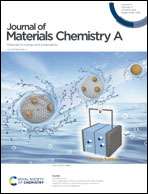Polyoxometalate driven dendrite-free zinc electrodes with synergistic effects of cation and anion cluster regulation†
Abstract
Even rechargeable aqueous Zn-ion batteries are regarded as one of the promising secondary batteries due to their high safety and low cost, but their practical applications are still hampered by the formation of zinc dendrites. Thus, in this work, we employ a classic Anderson-type polyoxometalate for the first time, (NH4)6[Mo7O24]·4H2O (NMO), as a stable electrolyte additive during repeated Zn plating/striping to significantly suppress zinc dendrite growth. The [Mo7O24]6− anion clusters can bind with massive Zn ions to produce a Zn-rich film, thus ensuring the uniform distribution of Zn ions on the surface of the Zn anode, while the NH4+ cation can further regulate the even Zn deposition during plating via electrostatic repulsion forces. As a result, the cycle life of Zn anodes in symmetric cells has improved approximately 100% in a wide range of current densities and the Zn/NaV3O8·1.5H2O (Zn/NVO) full cells also demonstrate high capacity retention and excellent fast charge/discharge capacity. The utilization of ultra-stable polyoxometalate additives with strong complexation with metal ions provides researchers with a new conception for constructing long-term cycling life aqueous rechargeable batteries.



 Please wait while we load your content...
Please wait while we load your content...